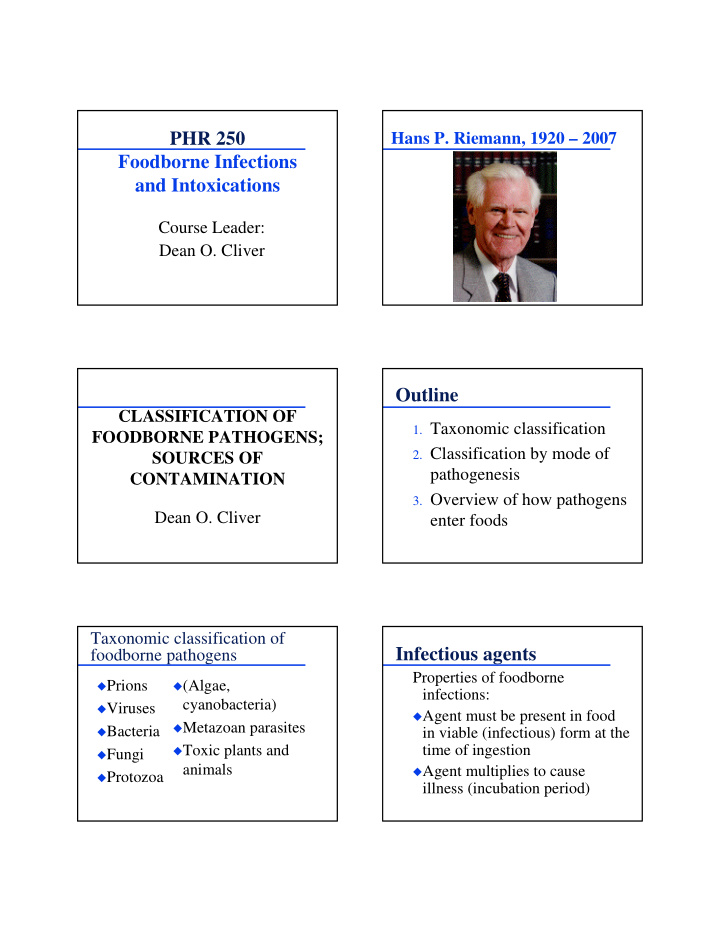



PHR 250 Hans P. Riemann, 1920 – 2007 Foodborne Infections and Intoxications Course Leader: Dean O. Cliver Outline CLASSIFICATION OF 1. Taxonomic classification FOODBORNE PATHOGENS; 2. Classification by mode of SOURCES OF pathogenesis CONTAMINATION 3. Overview of how pathogens Dean O. Cliver enter foods Taxonomic classification of Infectious agents foodborne pathogens Properties of foodborne � Prions � (Algae, infections: cyanobacteria) � Viruses � Agent must be present in food � Metazoan parasites � Bacteria in viable (infectious) form at the � Toxic plants and time of ingestion � Fungi animals � Agent multiplies to cause � Protozoa illness (incubation period)
Infectious agents Infectious agents � Prions—new variant CJD � Protozoa— Cryptosporidium parvum , Entamoeba histolytica , � Viruses—hepatitis A, Giardia lamblia , Toxoplasma noroviruses, etc. gondii , etc. � Bacteria— Campylobacter , � Metazoan parasites— Clostridium perfringens , roundworms, tapeworms, flukes Escherichia coli , Listeria , Salmonella , Shigella , Vibrio , etc. Intoxicating agents Intoxicating agents Properties of foodborne � Bacteria— Bacillus cereus , intoxications: Clostridium botulinum , � Toxic substance is present in Staphylococcus aureus food at the time of ingestion � (Algae, cyanobacteria) � Onset of illness is often more rapid Other classes of Intoxicating agents foodborne disease "Exceptional" foodborne � Fungi— Aspergillus , Fusarium , diseases: Penicillium , etc. � Allergy—serologic reaction � Toxic plants and animals— � Intolerance—enzyme mushrooms, cassava, fugu, etc. deficiency (abnormal � Chemicals people?)
Other classes of "Food Chain" foodborne disease Idiopathic illnesses: Grower Retailer (Inputs) � Acute—"Chinese restaurant syndrome” Distributor Consumer � Chronic—cancer, heart disease Processor Food Service Sources of foodborne pathogens Sources of foodborne pathogens Preharvest: Preharvest: � Zoonoses— � Inherent toxicants—acorns, enterohemorrhagic E. coli , cassava, olives, etc. Trichinella spiralis , ( Brucella, Coxiella burnetii, Mycobacterium bovis, prions of BSE), etc. Sources of foodborne pathogens Sources of foodborne pathogens Harvest or slaughter: Preharvest: � Cross-contamination— � Field contaminants— Listeria , Salmonella Cryptosporidium parvum , � Water—enterohemorrhagic E. enterohemorrhagic E. coli , coli , hepatitis A virus, etc. Vibrio parahaemolyticus , etc. � Humans—hepatitis A virus, Salmonella , etc.?
"Food Chain" Sources of foodborne pathogens Processing: Grower Retailer (Inputs) � Problems rare in U.S. at present Distributor Consumer � Colonization of facilities by Listeria , Salmonella � If bakeries are included, Processor Food Service viruses "Food Chain" Sources of foodborne pathogens Grower Retailer � Storage and distribution— (Inputs) most problems with temperature control, rather Distributor Consumer than contamination Food Service Processor "Food Chain" Sources of foodborne pathogens Retailing and food service; Grower Retailer (Inputs) � Opportunities for human-source contamination: hepatitis A virus, Shigella , pathogenic E. coli Consumer Distributor (other than EHEC) � Cross-contamination with EHEC, Food Service Processor Listeria , Salmonella , etc.
"Food Chain" Sources of foodborne pathogens Final preparation and serving Grower Retailer (Inputs) � Opportunities for human- source contamination: –bacteria & viruses Distributor Consumer – Giardia lamblia – Taenia solium Processor Food Service –etc. Summary � Foodborne pathogens can be classified –taxonomically or –by mode of pathogenesis � Pathogens may enter food at any stage; some risks are more easily remedied than others
Recommend
More recommend